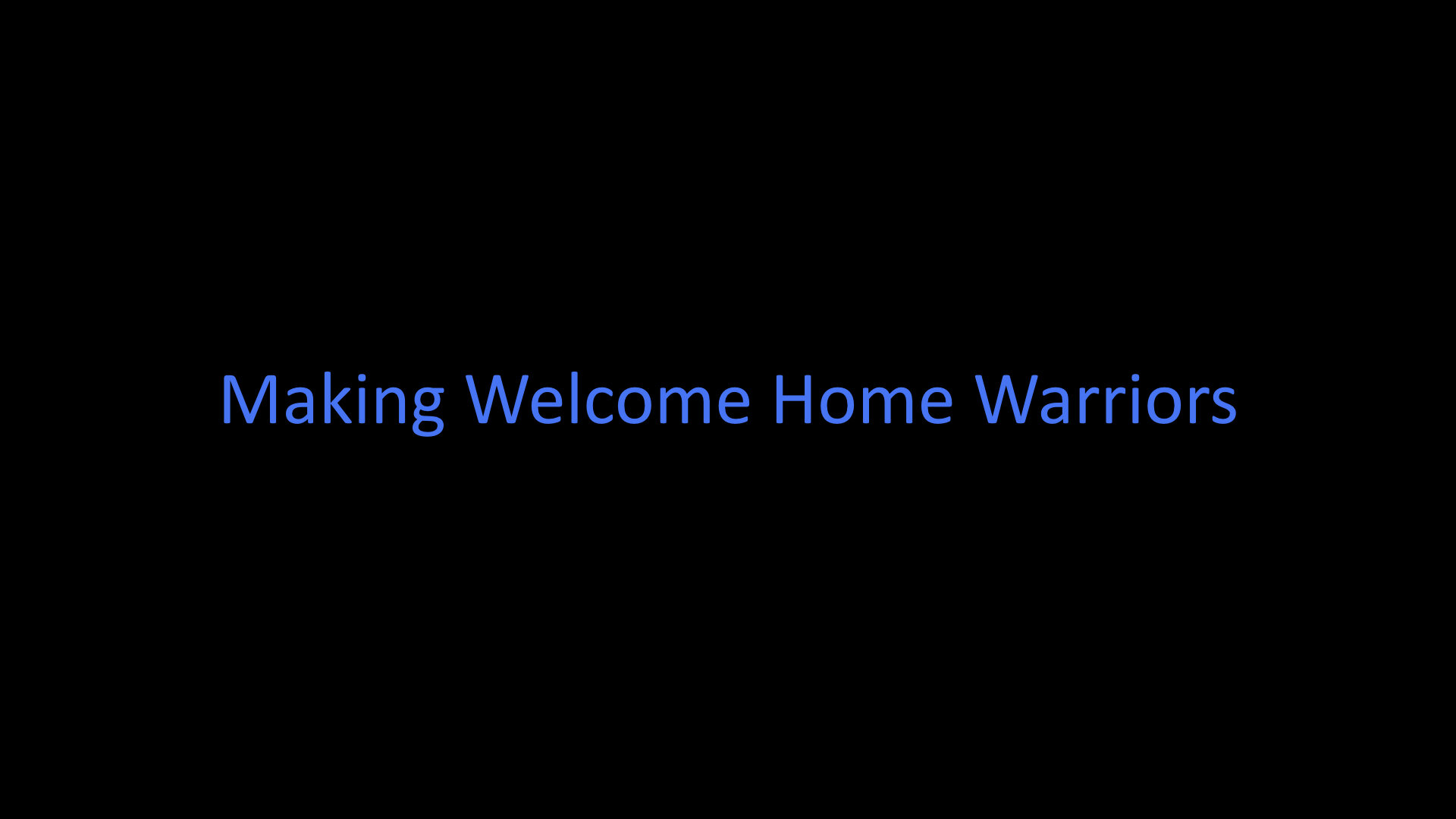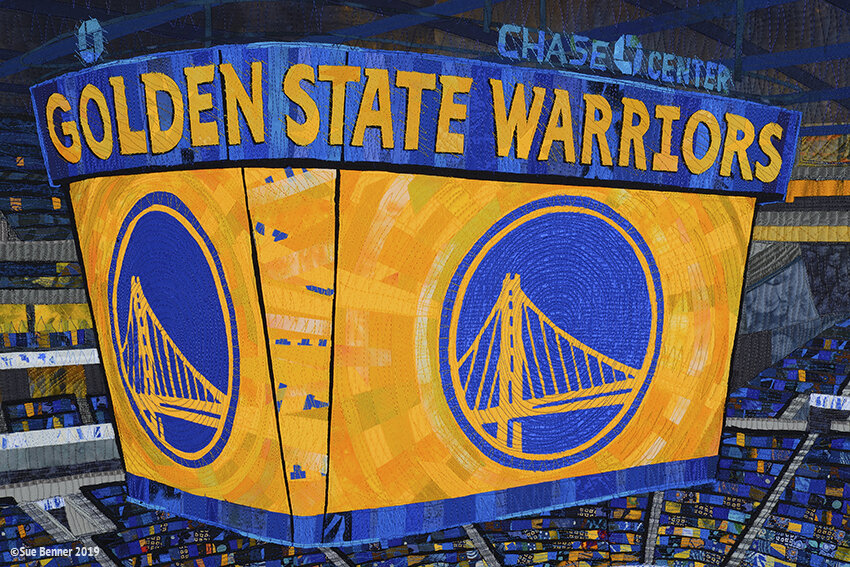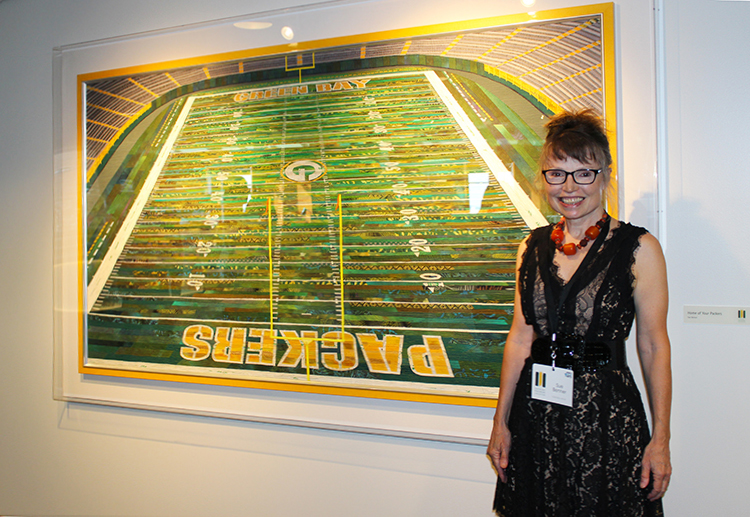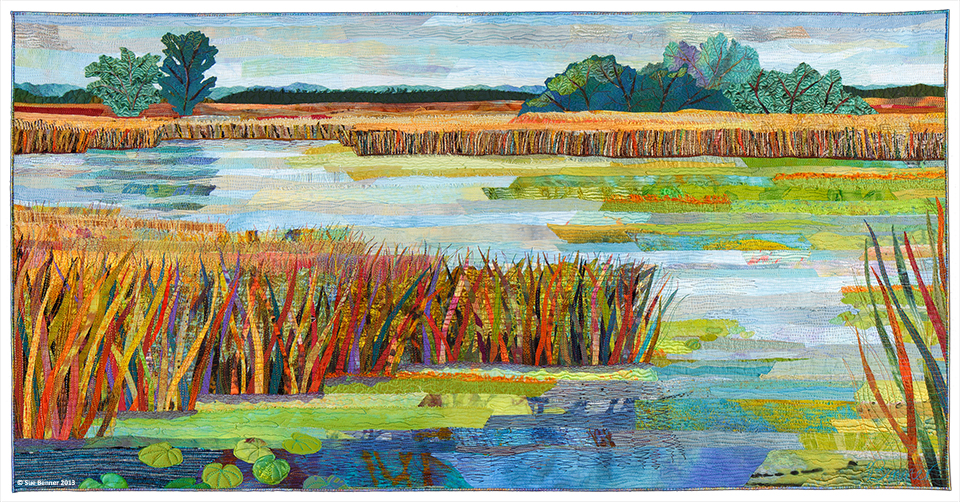Commissions and Projects
MESH 9: ATMOSPHERE
Statement:
During my Mesh series of textile works, I have been working with concepts of patching, mending and healing. In this commission for Ellen and Larry Keeshan, I thought of the mesh as a net, capturing a piece of the sky, a bit of atmosphere, and bringing it into their beautiful home.
I experimented with my materials until I achieved just the balance I was looking for: a palette of soft sky colors and the effect of sunlight filtered through foliage. It’s a work as light as air, soothing and serene. See images of the process and the installation.
Watch the video below to understand the process.
Mesh 9: Atmosphere: 114”H X 90”W, 2019. Textile Collage: Dye and paint on silk organza, found fabric, monoprinted, hand and machine stitched installed in the home of Ellen and Larry Keeshan.
Mesh 9: Atmosphere: detail: overlapping grid..
Mesh 9: Atmosphere: detail, Interplay of opaque and translucent fabric.
WELCOME HOME WARRIORS
Welcome Home Warriors: 43.25”H x 66.5”W, 2019, Art Quilt: dye and paint on silk, cotton, linen, polyester, Golden State Warriors jerseys and found fabrics, thread (cotton, polyester, rayon); fused collage, hand-guided free-motion machine quilting
Welcome Home Warriors: - Detail
I knew the gold and blue team colors would further help direct the choice of the many fabrics I could use. The “fans,” dressed in their colors, abstractly sway in their seats.
With these concepts I began work by making a full scale pattern to analyze the court’s layout and the perspective captured in the rendering.
I then gathered as many blue and gold fabrics from my studio as I could find of various fiber contents and every shade. I specially dyed and painted many as well. By taking the colors of the jerseys (gold, blue, gray, white) and combining them with every other variation of blue and gold available, I realized I could make the whole composition in just these colors.
Piece by piece, section by section, the composition came together. I stitched the entire collaged textile surface with free motion machine quilting. The stitching added texture and details while holding the layers of the quilt together.
Welcome Home Warriors: - Detail
Statement
Excited fans await to welcome the Golden State Warriors to their new home, the Chase Center in San Francisco, California. Let’s Go Warriors!
Translating the excitement of a new arena and home for the Golden State Warriors into a dynamic work of textile art was my challenge. In fact, the arena was only in the process of being built, making it even more imaginative. I was provided with the perspective renderings of the arena and plans for the scoreboard, but no other images for the space existed—not yet.
I knew quickly that the glowing scoreboard and basketball court needed to be the focus, so the central positioning in the composition was a clear choice… and when Sports and the Arts (SATA) asked me if I could include Golden State Warriors’ jerseys into the mix of fabrics I used for the quilt surface, I was thrilled.
Welcome Home Warriors: - Detail
TIDAL WETLANDS I AND II
Tidal Wetlands I and II. 27”H x 65.5” W (each). Dye and paint on cotton, silk, found fabrics, fused collage, machine quilted
Statement:
This diptych was commissioned in 2018 by a medical center in Jacksonville, Florida, an area known for its tidal wetland preserves and river estuaries.
Wetlands, whether the tidal salt marshes of the Florida coast or the freshwater marshes of Wisconsin, are an endless source of inspiration for me. The horizontal expanses of luxuriant flora and vibrant skies are amplified by their reflection in the water’s surface.
Collection of: a medical center in Jacksonville FL
SELF-PORTRAIT PROJECT 32/62
A few images from the original video
Statement:
The seed of this self-portrait began many years ago when a workshop student in Germany gave me a pink cotton bedsheet with a larger-than-life print of a wide-eyed young woman designed by the Japanese artist and illustrator, Mira Fujita.
The image reminded me of an idealized (and more beautiful) version of myself around the time of my wedding—the shape of her face, her curly hair (I had a perm at the time) and the flowers in her hair (I wore a pouf of silk organza flowers in lieu of a hat, or god-forbid, a veil). I knew I would make something with this cotton sheet one day, but put it away for over fifteen years, occasionally coming across it when organizing my studio.
When Through Our Hands (a former organization of international textile artists) proposed the Portrait exhibition, my husband and I were approaching our 30th wedding anniversary. I rescued the sheet and realized it was time to think about three decades of change. Who was that young, optimistic 32 year old woman? Who is she now at 62?
This led to the solution of making two works: one collaged directly on the bedsheet itself, and the other collaged over a fabric print of the first. Just to make myself even more self-conscious, I thought to record the whole process with a time-lapse video. I set forth, not knowing where this project would lead me or how I could accomplish my vision.
I figured it out along the way—and came face-to-face with my aging self.
On the left: Self-Portrait as Bride, 62 H X 45 W in, 2017, textile collage on cotton sheet with Mira Fujita image. On the Right: Self-Portrait Age-Progressed, 62 H X 45 W in, 2017, textile collage on print of Self-Portrait as Bride
THROUGH THE GRID
Inspiration, works and installation of exhibition at Visions Art Museum, 2017
Solo Exhibition at Visions Art Museum,
San Diego CA
Statement:
Intersecting lines at right angles—the grid conjures youthful memories of wearing wool plaid clothes, my mother teaching me how to sew, years of working with textiles as an art medium and my more recent fascination with wire fences.
I like what happens when I look through the grid, like peering into and past a wire mesh, chain link or even slatted fence. It forms a scrim for the scene behind—making instant units, providing instant analysis and in a way, making an instant quilt.
I carry my camera wherever I go, noticing, composing, recording, collecting. Many of these ideas are presented here in this work. The work evolved as I walked.
Mesh 7: Mend, 43 H X 40 W in, textile collage
Green Bay Packers Collection
lambeau field,green bay, wisconsin
In 2016 Sue Benner was contacted by Sports and the Arts (SATA) on behalf of The Green Bay Packers Organization to create two pieces for their "Walls of Lambeau Field" collection. This collection features works completed by artists who have direct Wisconsin ties or an affinity for the "Green & Gold." Benner talks about the commission.
Stories about all artists and artwork in the collection, including the commissioning of Home of Your Packers and Where It Counts, are also featured in an episode of Packers Life on February 5, 2018. The program contains an interview with Benner (at 14:35) and shows her working process and studio.
These two works, along with works by other artists are installed on the 4th through 6th floors of Lambeau Field and were dedicated in July of 2017.
Home of Your Packers, 44 H x 78.5 W in, 2017, dye and paint on silk, cotton, commercial and found fabrics (silk, cotton, rayon, polyester, acetate), fused collage, machine quilted.
Home of Your Packers
Statement:
We are here at this beautiful green field, Lambeau Field, the Home of Your Packers. The stage is set; everything is perfect and ready to go. The solid geometry and distinctive markings of the field speak of what is to come. The design of this game makes itself known in this structure. It is a challenge of yards: some gained, others lost, and the goal ultimately won.
Home of Your Packers, Detail
Where It Counts, 43 H x 31.25 W, 2017, dye and paint on silk, cotton, commercial and found fabrics (silk, cotton, rayon, polyester, acetate), fused collage, machine quilted.
Where It Counts, Detail
Where it counts
Statement:
Lambeau Field has the sky for a ceiling and the weather as a player in the game. The goalposts in this dramatic perspective view, reach up into the blueness, issuing a challenge to any team that plays here.
The fact that the Packers’ historic stadium continues to be open to the seasons, in Green Bay, Wisconsin, is an act of bravery. The Packers invite the weather in and stand up to it. It is part of their legend and strength.
PALO DURO CANYON: FORTRESS CLIFF
Palo Duro Canyon: Fortress Cliff , 28 H X 84 W in, 2015, dye and paint on silk, cotton, found fabrics, fused collage, machine quilted
Palo Duro Canyon is the second largest canyon system in the United States and is located near Amarillo, Texas. BNSF Railway, under the guidance of Sally King, curator, commissioned this work for their contemporary Southwest landscape collection.
Statement:
Immersing myself in the landscape is an exciting part of my creative process, and the relatively nearby Palo Duro Canyon State Park offered the dramatic panoramic vistas essential to the commission. While hiking, photographing and learning to understand the canyon terrain in the 104 degree temperature of August 2015, I fell in love with landscape. After poring over hundreds of my photos and sketching ideas, three compositions emerged as possibilities; and one became the basis for the final piece,
Palo Duro Canyon: Fortress Cliff.
While my goal is to depict a specific place, I also intend for my landscape work to be deeply rooted in the material. I compose with fabric not only because of its physical aspects of color and texture, but also for its emotional, humorous and ironic qualities.
Above are two detail shots from Palo Duro Canyon: Fortress Cliff
Commissions for mayo clinic, Rochester, Minnesota
Mayo Clinic commissions in order:
Willow Creek, View to the South 1 & 2; View from Grand River Road; View from Wiouwash Trail; View From Country Road D
Statement:
Experiencing the beauty and endless variation of the landscape is one of the great joys of my life. These scenes of wetlands, the merging of land and water, are common in the upper Midwest where I grew up. Now I long for them and visit every chance I get with my camera handy.
I hope that these works bring as much inspiration and serenity to the patients, visitors and staff of Mayo Clinic in Rochester, Minnesota as they bring to me. I am honored to be able to create these site-specific works for their exceptional care-giving medical facilities.
See more Wisconsin inspired works under Marsh and Wisconsin Wetlands galleries.
Visual Arts and healing with Baylor University, Waco, texas
Avance Center Letter Quilt (Serape), 31 H X 92 W in, 2014, cotton, silk, fused collage, machine and hand stitched. Created as a service learning project for AVANCE WACO by students in the Medical Humanities 3300 Class, at Baylor University, Waco, Texas, spring semester 2014.
avance center Letter Quilt
Sue Benner was guest artist in the Medical Humanities Department at Baylor University in Waco, Texas, during the spring semester of 2014. The class, Visual Arts and Healing, was created to give future healthcare professionals an insight into how art can enhance their medical and scientific training.
As a cornerstone of the class, the students were required to design and execute a service learning project for a nonprofit agency. Course director, Linda Bostwick, BSN, MN, FNP, asked Sue Benner, MA, a textile artist from Dallas, Texas, to work along with two members of the Baylor art faculty, Mary Ruth Smith, MFA, PhD, and Leah Force, BFA, MFA, to facilitate the making of a work of art to enrich the environment of the Avance Center in East Waco. The Avance Parent-Child Education Program’s mission is to strengthen communities through parent education in child development, literacy and school readiness.
The healthcare students enrolled in the course visited the Center to gather information about the space and program, and then participated in a brainstorming session with Benner to develop a theme for the quilt. The students chose “serape” as the unifying visual idea because of its dynamic colors, graphic stripes and link to the Hispanic community that Avance has traditionally served. The students felt strongly that the quilt should have an education purpose as well, so they chose to include letters of the alphabet.
Each student designed a quilt square that included a single letter on a striped ground. Benner guided them in the construction, design and machine quilting of the squares, while Smith and Force prepared many of the materials and instructed them in hand stitching and embroidery. The students were required to complete at least one letter square, some contributing two. Benner took the quilted squares back to her studio, added decorative machine stitching, arranged and assembled the squares. The final piece, THE AVANCE LETTER QUILT, measures 31 X 92 inches, and is composed of collaged cottons and silks, many of which were donated to the cause. The students machine quilted their squares and some added elaborate hand embroidery.
This project allowed students to explore how art affects an environment and gave them a concrete experience of working with their hands. The curriculum also emphasized visual analysis, attention to detail, collaborative work, aspects of art therapy and the development of fine motor skills and its application in their future medical careers. The students were surprised to discover the therapeutic effects of making art while using a needle and thread.
QUILTS: THE NEW GEOMETRY, Madi Museum, dallas, Texas
Watchful Eye XII: Ogalu Intersect, 2014
Wearing Plaid 2, 2011, private collection
Excerpts from exhibition catalog essay by Sue Benner, curator
Long before Mondrian’s Composition with Grid, quilters were making glorious geometric abstractions by sewing together pieces of cloth. It’s hard to imagine that pioneers in Abstract Art could have failed to notice how analogous was the quilt form, for already by the late 1800’s, an unknown quilter from Lancaster County, Pennsylvania, had hand-stitched a violet square inside a blue square inside a brown square. The resulting Center Square Amish quilt is as elegant as an Albers and as expressive as a Klee. Amish quilts can be seen as the prophets of the Modernist use of color and form as subject.
For this exhibition at the Museum of Geometric and MADI Art, I am addressing the nonobjective geometric abstraction inherent to quilts and the contemporary practice of this art form. I sought out works from American artists working in a style that most directly reflects the MADI aesthetic: geometric quilts with bold shapes and striking colors.
The geometry comes directly out of the cloth itself and the process of sewing. Cloth is woven with a warp and weft at right angles to each other, and tears along these lines quite easily. Even when carefully cutting fabric to a size, the square, rectangle, and strip are obvious and certainly the easiest to sew back together. Complicated curves can be cut and sewn, but additional skill and attention is needed. So fabric is ripped, cut, stitched back together, and grids and other geometric structures are formed. This is not to say that the quilt is accidentally beautiful or unintentionally powerful—quite the contrary
. . .
I have included two works of mine that evolved from geometry as an organizing principle, Watchful Eye XII and Wearing Plaid 2. I have been working in the quilt medium for over thirty years and experimented with widely ranging forms and imagery. Geometric abstraction remains the place where my mind can play and hands can find joy in placing one fabric next to another. It is the purest form of my expression.
. . .
There are many things to say about the history of quilts and the (mostly) women who made them: how great beauty and utility was made from bits and pieces of fabrics; how inventive design was born of limited resources; how they covered beds and provided warmth; or how they created connections in communities. We can debate about whether the makers of quilts from long ago had any recognition of their artistic intent, but we cannot deny their instinct for composition and invention. How can you sew two fabrics together, then three, four, a thousand and not know you are creating something of beauty and importance? Now, working as artists, we self-consciously make our quilts, trying to live up to the gifts of our tradition, and pushing ourselves into new territory and geometry.
Please note: The Museum of Geometric and MADI Art has permanently closed its doors as of 2021.
Centennial Celebration Quilt for the First Unitarian Church
of Dallas, texas
Centennial:
Circles Squared, Curved Space
This is a work of creation and evolution, of reflection and collaboration.
The quilt began with a charge from the Centennial Celebration Committee to create an artwork to hang in the sanctuary to commemorate 100 years of church history. I commenced with a desire to incorporate various levels of meaning into the structure of the artwork: a grid of one hundred squares, curved outlines suggesting a chalice with flame and symbolic representations of Unitarian Universalist principles. I wanted the work to invite interpretation, contemplation and discovery.
The artwork is essentially four silk quilts, together making a one hundred-eight inch square. Each of the four equal sections has an identical chalice and flame design. The rim of a chalice is suggested as a gentle curve, with tongue-like flames rising out of this arc. By rotating the orientation of each of the four sections ninety degrees, another design is made—a swirling form, a whirlpool, a galaxy. At the center where the four sections meet is space for imagining the mystery.
Over the whole work there is a scattering of confetti to celebrate 100 years of community in liberal religion.
Centennial: Circles Squared, Curved Space, 108 H X 108 W in (four quilts at 54 H X 54 W in each), 1999, dye and paint on silk, cotton, fused collage, machine quilted, First Unitarian Church, Dallas TX
Alternatively, the work can be hung as four separate works across the front of the sanctuary, or in pairs at the sides. Because of this versatility, and a rotating schedule that the church and I developed for display, the view of the art is refreshed from year to year.
Brain Quilt, 66 H X 60 W in, 1981 and 2015, dye on silk (batik), cotton, machine and hand pieced, hand quilted by Julie Steger, Caroline Walker and Sue Benner, Department of Neurological Surgery, UT Southwestern Medical Center, Dallas TX
Brain Quilt
The Brain Quilt was originally commissioned in 1981 by Medical Illustration Services (MIS), a division of the Department of Biomedical Communications at the University of Texas Southwestern Medical and Graduate School. In 2013, Lewis Calver, Director of Biomedical Communications, arranged for the Brain Quilt to be given to the Department of Neurological Surgery, Hunt Batjer, MD, Chairman.
In 2014, the new owners asked me to review and refurbish the work. I removed the commercially-dyed velvet outer border and replaced it with custom-dyed cotton velveteen. I also added quilting in the inner borders (sashing) and in the new outer border. The Brain Quilt was re-framed in June of 2015 and installed in the conference room of the Department of Neurological Surgery.
I am a graduate (Master of Arts in Biomedical Communications, Medical Illustration) from this institution.
The Brain Quilt illustrates nine horizontal sections of the human brain with emphasis on the visual and auditory pathways.















































